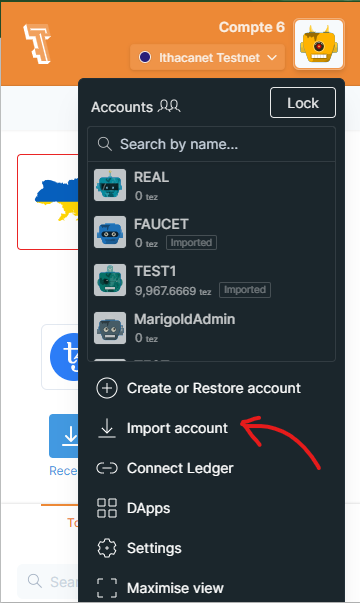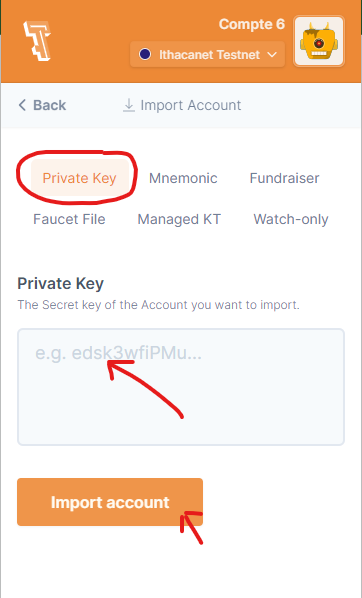| title | tags | description |
|---|---|---|
Training dapp n°1 |
Training |
Training n°1 for decentralized application |
dapp : A decentralized application (dApp) is a type of distributed open source software application that runs on a peer-to-peer (P2P) blockchain network rather than on a single computer. DApps are visibly similar to other software applications that are supported on a website or mobile device but are P2P supported
Goal of this training is to develop a poke game with smart contract. You will learn :
- create a smart contract in jsligo
- deploy smart contract
- create a dapp using taquito and interact with browser wallet
- use an indexer
⚠️ This is not an HTML or REACT training, I will avoid as much of possible any complexity relative to these technologies
The game consists on poking the owner of a smart contract. The smartcontract keeps a track of user interactions on the storage
Poke sequence diagram
sequenceDiagram
Note left of User: Prepare poke
User->>SM: poke owner
Note right of SM: store poke trace
Please install this software first on your machine or use online alternative :
- VS Code : as text editor
- npm : we will use a typescript React client app
- yarn : because yet another
- ligo : high level language that's transpile to michelson low level language and provide lot of development support for Tezos
- tezos-client (method 1) or tezos-client (method 2) : the Tezos CLI
- Temple wallet : an easy to use Tezos wallet as browser plugin
Alternative using GitPod : https://gitpod.io/#https://gitlab.com/ligolang/template-ligo (setup may take several minutes the first time)
Tips for VS Code code highlighting :
mkdir smartcontract
touch ./smartcontract/pokeGame.jsligoAdd a main function
type storage = unit;
type parameter =
| ["Poke"];
type return_ = [list<operation>, storage];
const main = ([action, store] : [parameter, storage]) : return_ => {
return match (action, {
Poke: () => poke(store)
}
)
};Every contract requires :
- an entrypoint, main by default, with a mandatory signature taking 2 parameters and a return :
- parameter : the contract
parameter - storage : the on-chain storage (can be any type, here
unitby default) - return_ : a list of
operationand a storage
- parameter : the contract
Doc : https://ligolang.org/docs/advanced/entrypoints-contracts
⚠️ You will notice that jsligo is a javascript-like language, multiple parameter declaration is a bit different. Instead of this declaration :(action : parameter, store : storage)You have to separate variable name to its type declaration this way :([action, store] : [parameter, storage])
Pattern matching is an important feature in Ligo. We need a switch on the entrypoint function to manage different actions. We use match to evaluate the parameter and call the appropriated poke function
Doc https://ligolang.org/docs/language-basics/unit-option-pattern-matching
match (action, {
Poke: () => poke(store)
} Poke is a parameter from variant type. It is the equivalent of Enum type in javascript
type parameter =
| ["Poke"];Doc https://ligolang.org/docs/language-basics/unit-option-pattern-matching#variant-types
We want to store every caller address poking the contract. Let's redefine storage, and then add the caller to the set of poke guys
type storage = set<address>;
const poke = (store : storage) : return_ => {
return [ list([]) as list<operation>, Set.add(Tezos.source, store)];
};Set library has specific usage :
Doc https://ligolang.org/docs/language-basics/sets-lists-tuples#sets
Here, we get the caller address using Tezos.source. Tezos library provides useful function for manipulating blockchain objects
The LIGO command-line interpreter provides sub-commands to directly test your LIGO code
Compile contract (to check any error, and prepare the michelson outputfile to deploy later) :
ligo compile contract ./smartcontract/pokeGame.jsligo --output-file pokeGame.tzCompile an initial storage (to pass later during deployment too)
ligo compile storage ./smartcontract/pokeGame.jsligo 'Set.empty as set<address>' --output-file pokeGameStorage.tz --entry-point mainDry run (i.e test an execution locally without deploying), pass the contract parameter Poke() and the initial on-chain storage with an empty set :
ligo run dry-run ./smartcontract/pokeGame.jsligo 'Poke()' 'Set.empty as set<address>' Output should give :
( LIST_EMPTY() ,
SET_ADD(@"tz1QL8xpMA9JwtUYXXwB6qnJTk8pkEakHpT4" , SET_EMPTY()) )You can notice that the instruction will store the address of the caller into the traces storage
Choose a testnet to deploy
For ithacanet :
tezos-client --endpoint https://ithacanet.tezos.marigold.dev config updateYou will need an implicit account on your local wallet and get free Tz from a [faucet] and download the .json file locally (https://teztnets.xyz/)
Doc : https://tezos.gitlab.io/introduction/howtouse.html#get-free-tez
Replace <ACCOUNT_KEY_NAME> by account key of your choice :
tezos-client activate account <ACCOUNT_KEY_NAME> with "tz1__xxxxxxxxx__.json"List all local accounts :
tezos-client list known addressesYour account should appear on the list now
Check your balance
tezos-client get balance for <ACCOUNT_KEY_NAME>🚀 You are ready to go 😎
Use the tezos-client to deploy the contract
tezos-client originate contract mycontract transferring 0 from <ACCOUNT_KEY_NAME> running pokeGame.tz --init "$(cat pokeGameStorage.tz)" --burn-cap 1Verify the output. a successful output display the address of the new created smart contract on the testnet
New contract KT1M1sXXUYdLvow9J4tYcDDrYa6aKn3k1NT9 originated.Interact now with it, poke it ! 😆
tezos-client transfer 0 from <ACCOUNT_KEY_NAME> to mycontract --burn-cap 0.01 Check that your address is registered on the storage
tezos-client get contract storage for mycontract HOORAY 🎊 your smart contract is ready !
yarn create react-app dapp --template typescript
cd dappAdd taquito, tzkt indexer lib
yarn add @taquito/taquito @taquito/beacon-wallet
yarn add @dipdup/tzkt-api
⚠️ If you are using last version 5.x of react-script, follow these steps to rewire webpack for all encountered missing libraries : https://github.com/ChainSafe/web3.js#troubleshooting-and-known-issues
Start the dev server
yarn run startOpen your browser at : http://localhost:3000/ Your app should be running
We will declare 2 React Button components and a display of address and balance while connected
Edit src/App.tsx file
import { useState } from 'react';
import './App.css';
import ConnectButton from './ConnectWallet';
import { TezosToolkit } from '@taquito/taquito';
import DisconnectButton from './DisconnectWallet';
function App() {
const [Tezos, setTezos] = useState<TezosToolkit>(new TezosToolkit("https://ithacanet.tezos.marigold.dev"));
const [wallet, setWallet] = useState<any>(null);
const [userAddress, setUserAddress] = useState<string>("");
const [userBalance, setUserBalance] = useState<number>(0);
return (
<div className="App">
<header className="App-header">
<p>
<ConnectButton
Tezos={Tezos}
setWallet={setWallet}
setUserAddress={setUserAddress}
setUserBalance={setUserBalance}
wallet={wallet}
/>
<DisconnectButton
wallet={wallet}
setUserAddress={setUserAddress}
setUserBalance={setUserBalance}
setWallet={setWallet}
/>
<div>
I am {userAddress} with {userBalance} Tz
</div>
</p>
</header>
</div>
);
}
export default App;Let's create the 2 missing src component files and put code in it
touch ConnectWallet.tsx
touch DisconnectWallet.tsxConnectWallet button will create an instance wallet, get user permissions via a popup and then retrieve account information
Edit ConnectWallet.tsx
import { Dispatch, SetStateAction, useState, useEffect } from "react";
import { TezosToolkit } from "@taquito/taquito";
import { BeaconWallet } from "@taquito/beacon-wallet";
import {
NetworkType
} from "@airgap/beacon-sdk";
type ButtonProps = {
Tezos: TezosToolkit;
setWallet: Dispatch<SetStateAction<any>>;
setUserAddress: Dispatch<SetStateAction<string>>;
setUserBalance: Dispatch<SetStateAction<number>>;
wallet: BeaconWallet;
};
const ConnectButton = ({
Tezos,
setWallet,
setUserAddress,
setUserBalance,
wallet
}: ButtonProps): JSX.Element => {
const setup = async (userAddress: string): Promise<void> => {
setUserAddress(userAddress);
// updates balance
const balance = await Tezos.tz.getBalance(userAddress);
setUserBalance(balance.toNumber());
};
const connectWallet = async (): Promise<void> => {
try {
if(!wallet) await createWallet();
await wallet.requestPermissions({
network: {
type: NetworkType.ITHACANET,
rpcUrl: "https://ithacanet.tezos.marigold.dev"
}
});
// gets user's address
const userAddress = await wallet.getPKH();
await setup(userAddress);
} catch (error) {
console.log(error);
}
};
const createWallet = async() => {
// creates a wallet instance if not exists
if(!wallet){
wallet = new BeaconWallet({
name: "training",
preferredNetwork: NetworkType.ITHACANET
});}
Tezos.setWalletProvider(wallet);
setWallet(wallet);
// checks if wallet was connected before
const activeAccount = await wallet.client.getActiveAccount();
if (activeAccount) {
const userAddress = await wallet.getPKH();
await setup(userAddress);
}
}
useEffect(() => {
(async () => createWallet())();
}, []);
return (
<div className="buttons">
<button className="button" onClick={connectWallet}>
<span>
<i className="fas fa-wallet"></i> Connect with wallet
</span>
</button>
</div>
);
};
export default ConnectButton;DisconnectWallet button will clean wallet instance and all linked objects
import { Dispatch, SetStateAction } from "react";
import { BeaconWallet } from "@taquito/beacon-wallet";
interface ButtonProps {
wallet: BeaconWallet | null;
setUserAddress: Dispatch<SetStateAction<string>>;
setUserBalance: Dispatch<SetStateAction<number>>;
setWallet: Dispatch<SetStateAction<any>>;
}
const DisconnectButton = ({
wallet,
setUserAddress,
setUserBalance,
setWallet,
}: ButtonProps): JSX.Element => {
const disconnectWallet = async (): Promise<void> => {
setUserAddress("");
setUserBalance(0);
setWallet(null);
console.log("disconnecting wallet");
if (wallet) {
await wallet.client.removeAllAccounts();
await wallet.client.removeAllPeers();
await wallet.client.destroy();
}
};
return (
<div className="buttons">
<button className="button" onClick={disconnectWallet}>
<i className="fas fa-times"></i> Disconnect wallet
</button>
</div>
);
};
export default DisconnectButton;Save both file, the dev server should refresh the page
Note on Temple wallet configuration Go to your browser plugin and import an account
Choose the private key, copy/paste that is located here : ~/.tezos-client/secret_keys
Once Temple is configured well, Click on Connect button
On the popup, select your Temple wallet, then your account and connect.
🎊 your are "logged"
Click on the Disconnect button to logout to test it
Remember that you deployed your contract previously. Instead of querying heavily the rpc node to search where is located your contract and get back some information about it, we can use an indexer. We can consider it as an enriched cache API on top of rpc node. In this example, we will use the tzkt indexer
Add the library
yarn add @dipdup/tzkt-apiWe will add a button to fetch all similar contracts to the one you deployed, then we display the list
Now, edit App.tsx to add 1 import on top of the file
import { Contract, ContractsService } from '@dipdup/tzkt-api';Before the return , add this section for the fetch
const contractsService = new ContractsService( {baseUrl: "https://api.ithacanet.tzkt.io" , version : "", withCredentials : false});
const [contracts, setContracts] = useState<Array<Contract>>([]);
const fetchContracts = () => {
(async () => {
setContracts((await contractsService.getSimilar({address:"KT1M1sXXUYdLvow9J4tYcDDrYa6aKn3k1NT9" , includeStorage:true, sort:{desc:"id"}})));
})();
}On the return 'html templating' section, add this after the display of the user balance div, add this :
<br />
<div>
<button onClick={fetchContracts}>Fetch contracts</button>
{contracts.map((contract) => <div>{contract.address}</div>)}
</div>Save your file and go to the browser. click on Fetch button
🎊 Congrats ! you are able to list all similar deployed contracts
Add some import at the top
import { TezosToolkit, WalletContract } from '@taquito/taquito';Add this new function inside the App function, it will call the entrypoint to poke
const poke = async (contract : Contract) => {
let c : WalletContract = await Tezos.wallet.at(""+contract.address);
try {
const op = await c.methods.default().send();
await op.confirmation();
} catch (error : any) {
console.table(`Error: ${JSON.stringify(error, null, 2)}`);
}
};
⚠️ Normally we should callc.methods.poke()function , but there is a bug while compiling ligo variant with one unique choice, then thedefaultis generated instead of having the name of the function. Also be careful because all entrypoints naming are converting to lowercase whatever variant variable name you can have on source file.
Then replace the line displaying the contract address by this one that will add a Poke button
{contracts.map((contract) => <div>{contract.address} <button onClick={() =>poke(contract)}>Poke</button></div>)}Save and see the page refreshed, then click on Poke button
🎊 If you have enough Tz on your wallet for the gas, then it should have successfully call the contract and added you to the list of poke guyz
To verify that on the page, we can display the list of poke guyz directly on the page
Replace again the html contracts line by this one
<table><thead><tr><th>address</th><th>people</th><th>action</th></tr></thead><tbody>
{contracts.map((contract) => <tr><td style={{borderStyle: "dotted"}}>{contract.address}</td><td style={{borderStyle: "dotted"}}>{contract.storage.join(", ")}</td><td style={{borderStyle: "dotted"}}><button onClick={() =>poke(contract)}>Poke</button></td></tr>)}
</tbody></table>Contracts are displaying its people now
ℹ️ Wait around few second for blockchain confirmation and click on "fetch contracts" to refresh the list
🎊 Congratulation, you have completed this first dapp training
Now, you are able to create any Smart Contract using Ligo and build a Dapp via Taquito to interact with it
On next training, you will learn how to call a Smart contract inside a Smart Contract and use the callback, write unit test, etc ...







